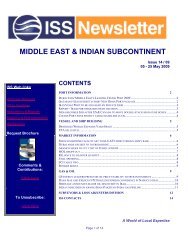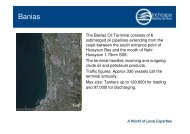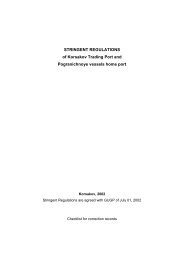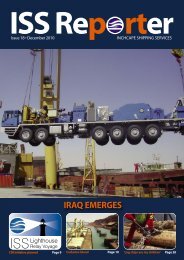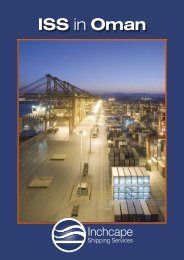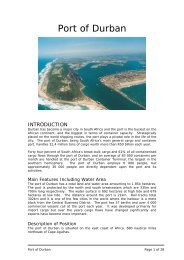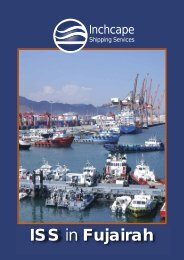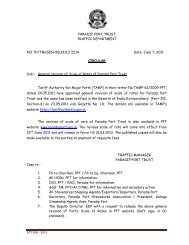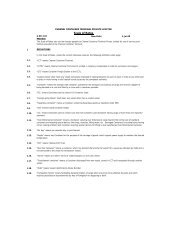Prigorodnoye Export Terminal Port Regulations.pdf - Inchcape ...
Prigorodnoye Export Terminal Port Regulations.pdf - Inchcape ...
Prigorodnoye Export Terminal Port Regulations.pdf - Inchcape ...
Create successful ePaper yourself
Turn your PDF publications into a flip-book with our unique Google optimized e-Paper software.
<strong>Prigorodnoye</strong> <strong>Export</strong> <strong>Terminal</strong> <strong>Port</strong> <strong>Regulations</strong> Rev 01<br />
Whilst alongside the terminal’s berths, no tug or any other craft shall be allowed alongside<br />
unless, cargo operations have been stopped, valves closed and cargo decks secured, except<br />
in the case of an emergency when the terminal may permit tugs or other craft to go alongside<br />
subject to the agreement of the ship’s Master.<br />
31.6 Shore Fire-fighting Equipment<br />
Fire-fighting equipment available from shore, as detailed in Appendix 9, will be 5 monitors, 2<br />
hydrants, 1 ISC hydrant and a water deluge on each arm with a fire box (for LNG).<br />
31.7 Ship’s Fire-fighting Equipment<br />
All ship’s fire-fighting equipment shall be in good working order. <strong>Port</strong>able equipment shall be<br />
correctly positioned, and ready for immediate use. The tanker’s fire main shall be pressurised<br />
whilst alongside the terminal’s berths. Precautions shall be taken, as appropriate, during the<br />
winter period to ensure the fire main does not become frozen.<br />
The ship/shore international connection shall be prominently identified with the connecting<br />
flange and bolts ready for immediate use on both ship and shore. Hoses shall be placed at<br />
both ship and shore international connections ready for immediate deployment.<br />
31.8 Main Engine Readiness<br />
Whilst alongside the LNG berth or moored to the TLU, the tanker's main engines and related<br />
auxiliaries shall be kept in a state of readiness such that the tanker can leave under her own<br />
power in an emergency. Maintenance work to the engines and auxiliaries is prohibited.<br />
In the case of a steamship this means that, the turning gear is to be engaged, main steam stop<br />
valve closed with turbines sufficiently warm and condenser vacuum maintained commensurate<br />
with the engine manufacturer's operating instructions. Allowance is made for those vessels<br />
with a continuous warm up system providing that safe guards remain in place to restrict<br />
significant accidental engine movement being made. For a diesel-powered ship this means<br />
that the fuel rail is under constant circulation and ‘starting-air’ bottles are fully charged.<br />
Whilst alongside the terminal’s berths, repairs and maintenance to the tanker’s machinery and<br />
equipment shall be restricted to those items, which do not impair or limit the use of:<br />
• Fire detection or fire-fighting capability.<br />
• Safe and efficient handling of the cargo.<br />
• Propulsion system or manoeuvrability of the tanker.<br />
• Integrity of the mooring system.<br />
• Safe operation of electrical equipment in gas dangerous zones.<br />
31.9 Testing Main Engines<br />
Under no circumstances should a tankers main engines be tested at any time whilst alongside<br />
the LNG berth or moored to the TLU until the loading arm(s) or hoses have been<br />
disconnected, shore or ship’s gangway removed and the tug(s) is/are secured alongside.<br />
0000-S-90-01-P-0207-00-E<br />
Page 62 of 101<br />
BM Code: EP.14.03.01.09



